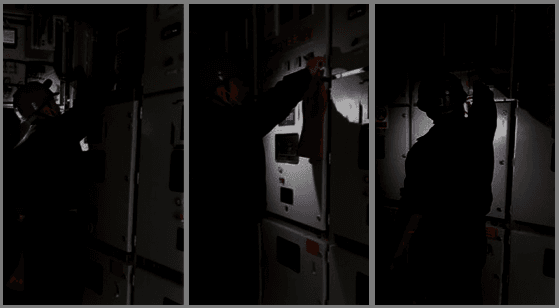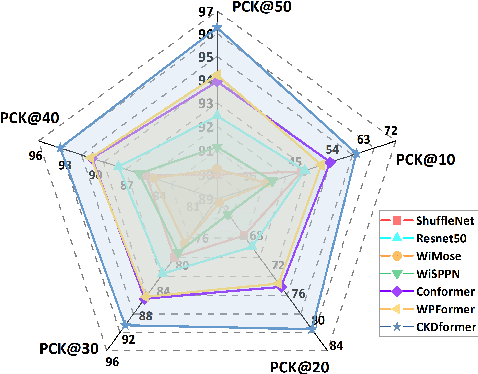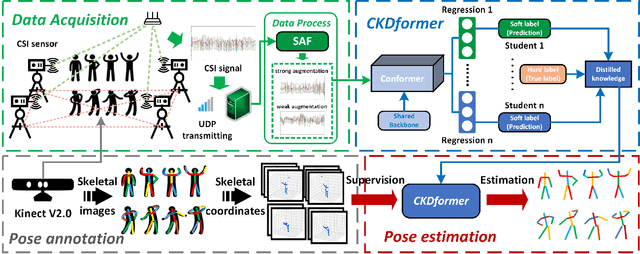Yunjiao Zhou
Generative Dataset Distillation using Min-Max Diffusion Model
Mar 24, 2025Abstract:In this paper, we address the problem of generative dataset distillation that utilizes generative models to synthesize images. The generator may produce any number of images under a preserved evaluation time. In this work, we leverage the popular diffusion model as the generator to compute a surrogate dataset, boosted by a min-max loss to control the dataset's diversity and representativeness during training. However, the diffusion model is time-consuming when generating images, as it requires an iterative generation process. We observe a critical trade-off between the number of image samples and the image quality controlled by the diffusion steps and propose Diffusion Step Reduction to achieve optimal performance. This paper details our comprehensive method and its performance. Our model achieved $2^{nd}$ place in the generative track of \href{https://www.dd-challenge.com/#/}{The First Dataset Distillation Challenge of ECCV2024}, demonstrating its superior performance.
IoT-LLM: Enhancing Real-World IoT Task Reasoning with Large Language Models
Oct 03, 2024



Abstract:Large Language Models (LLMs) have demonstrated remarkable capabilities across textual and visual domains but often generate outputs that violate physical laws, revealing a gap in their understanding of the physical world. Inspired by human cognition, where perception is fundamental to reasoning, we explore augmenting LLMs with enhanced perception abilities using Internet of Things (IoT) sensor data and pertinent knowledge for IoT task reasoning in the physical world. In this work, we systematically study LLMs capability to address real-world IoT tasks by augmenting their perception and knowledge base, and then propose a unified framework, IoT-LLM, to enhance such capability. In IoT-LLM, we customize three steps for LLMs: preprocessing IoT data into formats amenable to LLMs, activating their commonsense knowledge through chain-of-thought prompting and specialized role definitions, and expanding their understanding via IoT-oriented retrieval-augmented generation based on in-context learning. To evaluate the performance, We design a new benchmark with five real-world IoT tasks with different data types and reasoning difficulties and provide the benchmarking results on six open-source and close-source LLMs. Experimental results demonstrate the limitations of existing LLMs with naive textual inputs that cannot perform these tasks effectively. We show that IoT-LLM significantly enhances the performance of IoT tasks reasoning of LLM, such as GPT-4, achieving an average improvement of 65% across various tasks against previous methods. The results also showcase LLMs ability to comprehend IoT data and the physical law behind data by providing a reasoning process. Limitations of our work are claimed to inspire future research in this new era.
PowerSkel: A Device-Free Framework Using CSI Signal for Human Skeleton Estimation in Power Station
Mar 04, 2024



Abstract:Safety monitoring of power operations in power stations is crucial for preventing accidents and ensuring stable power supply. However, conventional methods such as wearable devices and video surveillance have limitations such as high cost, dependence on light, and visual blind spots. WiFi-based human pose estimation is a suitable method for monitoring power operations due to its low cost, device-free, and robustness to various illumination conditions.In this paper, a novel Channel State Information (CSI)-based pose estimation framework, namely PowerSkel, is developed to address these challenges. PowerSkel utilizes self-developed CSI sensors to form a mutual sensing network and constructs a CSI acquisition scheme specialized for power scenarios. It significantly reduces the deployment cost and complexity compared to the existing solutions. To reduce interference with CSI in the electricity scenario, a sparse adaptive filtering algorithm is designed to preprocess the CSI. CKDformer, a knowledge distillation network based on collaborative learning and self-attention, is proposed to extract the features from CSI and establish the mapping relationship between CSI and keypoints. The experiments are conducted in a real-world power station, and the results show that the PowerSkel achieves high performance with a PCK@50 of 96.27%, and realizes a significant visualization on pose estimation, even in dark environments. Our work provides a novel low-cost and high-precision pose estimation solution for power operation.
T3DNet: Compressing Point Cloud Models for Lightweight 3D Recognition
Feb 29, 2024Abstract:3D point cloud has been widely used in many mobile application scenarios, including autonomous driving and 3D sensing on mobile devices. However, existing 3D point cloud models tend to be large and cumbersome, making them hard to deploy on edged devices due to their high memory requirements and non-real-time latency. There has been a lack of research on how to compress 3D point cloud models into lightweight models. In this paper, we propose a method called T3DNet (Tiny 3D Network with augmEntation and disTillation) to address this issue. We find that the tiny model after network augmentation is much easier for a teacher to distill. Instead of gradually reducing the parameters through techniques such as pruning or quantization, we pre-define a tiny model and improve its performance through auxiliary supervision from augmented networks and the original model. We evaluate our method on several public datasets, including ModelNet40, ShapeNet, and ScanObjectNN. Our method can achieve high compression rates without significant accuracy sacrifice, achieving state-of-the-art performances on three datasets against existing methods. Amazingly, our T3DNet is 58 times smaller and 54 times faster than the original model yet with only 1.4% accuracy descent on the ModelNet40 dataset.
MaskFi: Unsupervised Learning of WiFi and Vision Representations for Multimodal Human Activity Recognition
Feb 29, 2024



Abstract:Human activity recognition (HAR) has been playing an increasingly important role in various domains such as healthcare, security monitoring, and metaverse gaming. Though numerous HAR methods based on computer vision have been developed to show prominent performance, they still suffer from poor robustness in adverse visual conditions in particular low illumination, which motivates WiFi-based HAR to serve as a good complementary modality. Existing solutions using WiFi and vision modalities rely on massive labeled data that are very cumbersome to collect. In this paper, we propose a novel unsupervised multimodal HAR solution, MaskFi, that leverages only unlabeled video and WiFi activity data for model training. We propose a new algorithm, masked WiFi-vision modeling (MI2M), that enables the model to learn cross-modal and single-modal features by predicting the masked sections in representation learning. Benefiting from our unsupervised learning procedure, the network requires only a small amount of annotated data for finetuning and can adapt to the new environment with better performance. We conduct extensive experiments on two WiFi-vision datasets collected in-house, and our method achieves human activity recognition and human identification in terms of both robustness and accuracy.
TENT: Connect Language Models with IoT Sensors for Zero-Shot Activity Recognition
Nov 14, 2023Abstract:Recent achievements in language models have showcased their extraordinary capabilities in bridging visual information with semantic language understanding. This leads us to a novel question: can language models connect textual semantics with IoT sensory signals to perform recognition tasks, e.g., Human Activity Recognition (HAR)? If so, an intelligent HAR system with human-like cognition can be built, capable of adapting to new environments and unseen categories. This paper explores its feasibility with an innovative approach, IoT-sEnsors-language alignmEnt pre-Training (TENT), which jointly aligns textual embeddings with IoT sensor signals, including camera video, LiDAR, and mmWave. Through the IoT-language contrastive learning, we derive a unified semantic feature space that aligns multi-modal features with language embeddings, so that the IoT data corresponds to specific words that describe the IoT data. To enhance the connection between textual categories and their IoT data, we propose supplementary descriptions and learnable prompts that bring more semantic information into the joint feature space. TENT can not only recognize actions that have been seen but also ``guess'' the unseen action by the closest textual words from the feature space. We demonstrate TENT achieves state-of-the-art performance on zero-shot HAR tasks using different modalities, improving the best vision-language models by over 12%.
AdaPose: Towards Cross-Site Device-Free Human Pose Estimation with Commodity WiFi
Sep 29, 2023Abstract:WiFi-based pose estimation is a technology with great potential for the development of smart homes and metaverse avatar generation. However, current WiFi-based pose estimation methods are predominantly evaluated under controlled laboratory conditions with sophisticated vision models to acquire accurately labeled data. Furthermore, WiFi CSI is highly sensitive to environmental variables, and direct application of a pre-trained model to a new environment may yield suboptimal results due to domain shift. In this paper, we proposes a domain adaptation algorithm, AdaPose, designed specifically for weakly-supervised WiFi-based pose estimation. The proposed method aims to identify consistent human poses that are highly resistant to environmental dynamics. To achieve this goal, we introduce a Mapping Consistency Loss that aligns the domain discrepancy of source and target domains based on inner consistency between input and output at the mapping level. We conduct extensive experiments on domain adaptation in two different scenes using our self-collected pose estimation dataset containing WiFi CSI frames. The results demonstrate the effectiveness and robustness of AdaPose in eliminating domain shift, thereby facilitating the widespread application of WiFi-based pose estimation in smart cities.
MM-Fi: Multi-Modal Non-Intrusive 4D Human Dataset for Versatile Wireless Sensing
May 12, 2023Abstract:4D human perception plays an essential role in a myriad of applications, such as home automation and metaverse avatar simulation. However, existing solutions which mainly rely on cameras and wearable devices are either privacy intrusive or inconvenient to use. To address these issues, wireless sensing has emerged as a promising alternative, leveraging LiDAR, mmWave radar, and WiFi signals for device-free human sensing. In this paper, we propose MM-Fi, the first multi-modal non-intrusive 4D human dataset with 27 daily or rehabilitation action categories, to bridge the gap between wireless sensing and high-level human perception tasks. MM-Fi consists of over 320k synchronized frames of five modalities from 40 human subjects. Various annotations are provided to support potential sensing tasks, e.g., human pose estimation and action recognition. Extensive experiments have been conducted to compare the sensing capacity of each or several modalities in terms of multiple tasks. We envision that MM-Fi can contribute to wireless sensing research with respect to action recognition, human pose estimation, multi-modal learning, cross-modal supervision, and interdisciplinary healthcare research.
Augmenting and Aligning Snippets for Few-Shot Video Domain Adaptation
Mar 18, 2023Abstract:For video models to be transferred and applied seamlessly across video tasks in varied environments, Video Unsupervised Domain Adaptation (VUDA) has been introduced to improve the robustness and transferability of video models. However, current VUDA methods rely on a vast amount of high-quality unlabeled target data, which may not be available in real-world cases. We thus consider a more realistic \textit{Few-Shot Video-based Domain Adaptation} (FSVDA) scenario where we adapt video models with only a few target video samples. While a few methods have touched upon Few-Shot Domain Adaptation (FSDA) in images and in FSVDA, they rely primarily on spatial augmentation for target domain expansion with alignment performed statistically at the instance level. However, videos contain more knowledge in terms of rich temporal and semantic information, which should be fully considered while augmenting target domains and performing alignment in FSVDA. We propose a novel SSA2lign to address FSVDA at the snippet level, where the target domain is expanded through a simple snippet-level augmentation followed by the attentive alignment of snippets both semantically and statistically, where semantic alignment of snippets is conducted through multiple perspectives. Empirical results demonstrate state-of-the-art performance of SSA2lign across multiple cross-domain action recognition benchmarks.
MetaFi: Device-Free Pose Estimation via Commodity WiFi for Metaverse Avatar Simulation
Aug 22, 2022



Abstract:Avatar refers to a representative of a physical user in the virtual world that can engage in different activities and interact with other objects in metaverse. Simulating the avatar requires accurate human pose estimation. Though camera-based solutions yield remarkable performance, they encounter the privacy issue and degraded performance caused by varying illumination, especially in smart home. In this paper, we propose a WiFi-based IoT-enabled human pose estimation scheme for metaverse avatar simulation, namely MetaFi. Specifically, a deep neural network is designed with customized convolutional layers and residual blocks to map the channel state information to human pose landmarks. It is enforced to learn the annotations from the accurate computer vision model, thus achieving cross-modal supervision. WiFi is ubiquitous and robust to illumination, making it a feasible solution for avatar applications in smart home. The experiments are conducted in the real world, and the results show that the MetaFi achieves very high performance with a PCK@50 of 95.23%.
 Add to Chrome
Add to Chrome Add to Firefox
Add to Firefox Add to Edge
Add to Edge